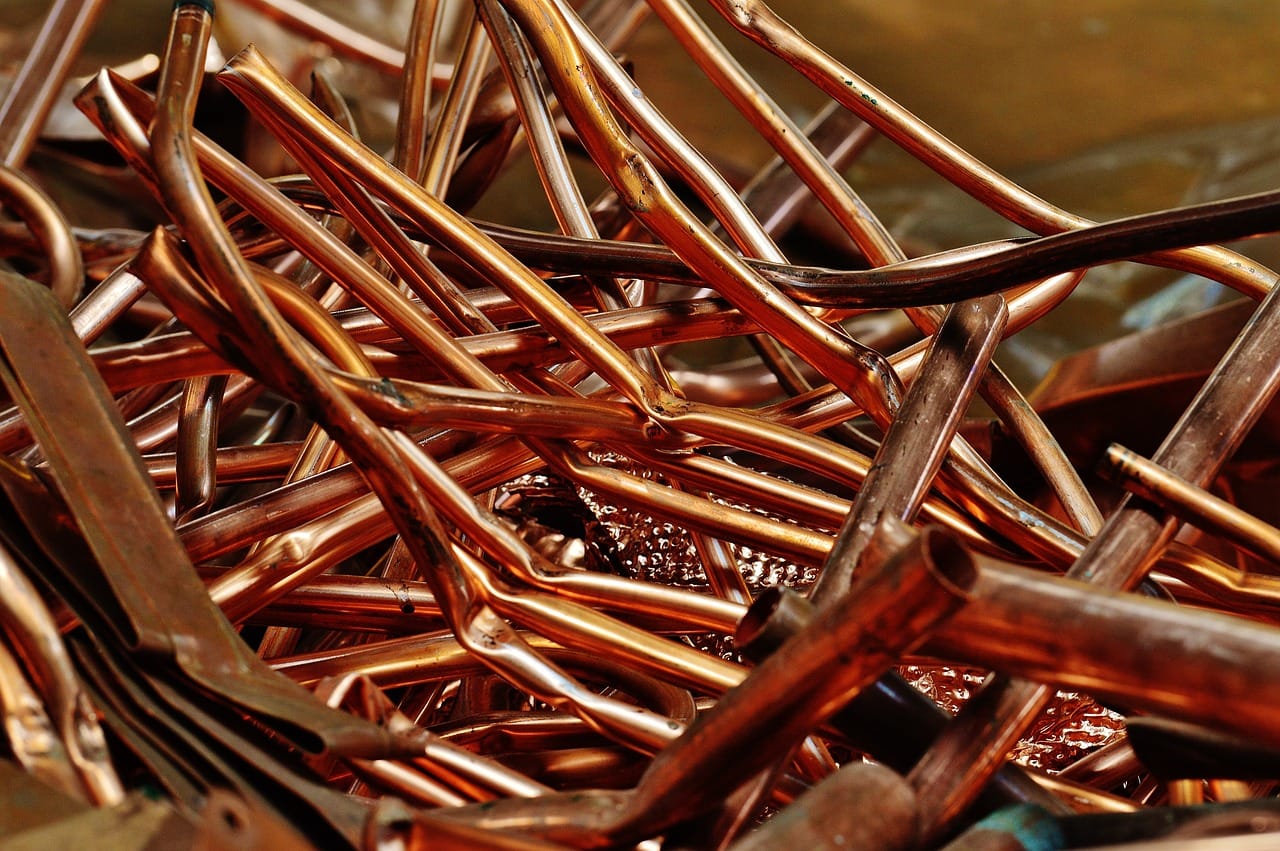If you go and have a look under your kitchen sink, there’s a good chance you’ll see the characteristic reddish shine of copper. Copper has been used for decades for all kinds of plumbing applications. It’s cheap, easy to work with, flexible and strong, making it ideal for conveying water and (depending on location) gas. That being said, if you live in a newer home, you’re more likely to see white uPVC as it gains prominence. It’s even harder wearing, more flexible and even cheaper. So if you do see copper, how long do you have before that needs replacing? How long do copper pipes last?
What Are Copper Pipes?
It should come as absolutely no surprise that copper pipes are pipes which are made of…copper.
They’ve been used for decades for all kinds of applications in the home. They’re relatively cheap while being strong and flexible enough to carry water under pressure, making them ideal supply pipes. They’re also non-reactive, meaning that the water carried by them tends to stay uncontaminated (which can’t be said for the lead and galvanized steel they replaced).
A brief history of copper pipes
If you live in an older home, you may still have sections of modern copper pipes’ precursors; galvanized steel or even lead (which you should get rid of ASAP). Since the 1940s, these have been being replaced with copper en masse as a far superior material for the job of supplying water.
The history of copper in plumbing actually goes back a lot further. About 4000 years further to be precise. There is good archaeological evidence of the ancient Egyptians using copper to convey water from place to place. The romans (who’s word for lead ‘Plumbum’ gives us both its sign on the periodic table and the word ‘plumbing’) also used it, though lead was more common. Given that we’re still finding these today, the answer to ‘how long do copper pipes last?’ seems to be ‘a very, very long time indeed’.
In the late 1940s, copper became the material of choice for interior plumbing. Since the 1990s, it’s slowly started to be replaced by modern plastics, but as it was so ubiquitous, it’s still probably the most common sight under sinks today.
Common Applications in homes and commercial plumbing
Copper is probably still the most common type of pipe in homes and businesses around the world. It’s strong, resistant to corrosion under most circumstances and easy to work with. It’s commonly used to supply water to fixtures and appliances. You’ll likely find it anywhere along the system from your water main including:
- Connecting faucets
- Inlets for washing machines and dish washers
- Connecting header tanks
- Supplying radiators
- Supplying water heaters
Basically, anywhere that needs a supply of water, copper has been the most common choice until very recently.
Types Of Copper Pipe
Copper pipe is broken up into 4 classifications: Types K, L, M and flexible copper tubing. Each of these comes in various diameters for different applications (the supply to your sink is thinner than that to your bath for example).
Type K
Type K copper pipe has the thickest walls. It’s used in all kinds of applications including:
- Oil
- HVAC
- Water distribution
- Fire protection
Because it’s so thick it’s ideal for water mains and underground applications as it’s strong enough to resist pressure from both internal and external sources.
Type L
Type L is thinner and can be used alongside a range of fittings. It’s by far the most commonly found in homes and businesses. It’s thinner than Type K but thicker than Type M piping, offering a good blend of durability and flexibility.
It can also be used outside as it can generally withstand exposure to the elements.
Type M
Type M is the thinnest of the 3 classifications. It’s usually used in residential settings where its cheapness gives it an edge (less thickness, less copper, less cost). Unfortunately, its thinness means some compromise on durability and as such, not all locations allow its use.
Flexible Copper Tubing
As the name suggests, flexible copper tubing is the most flexible of all the types of copper piping. It’s not very strong, so it was mostly used for drainage in older homes. It’s all but been phased out and replaced with plastic pipes.
Average Lifespan of Copper Pipes
If you’re wondering how long copper pipes last, the answer is ‘it depends’. As a general rule of thumb, you can expect copper pipes to have a lifespan of anywhere between 50-70 years before they need largescale repairs. There are factors which can improve or reduce the lifespan of copper plumbing which we’ll get onto in a moment.
In comparison to other common plumbing systems this 50-70 year lifespan looks like this:
- PVC: while it’s not much use for supply, PVC is the most common type of pipe used in drains. We don’t actually have a solid lifespan for it yet because it lasts and lasts and lasts.
- PEX: The pipes that are quickly replacing copper. PEX (or Crosslinked Polyethylene if you’re being fancy) will only last 40-50 years, but it’s even cheaper and easier to work with.
- Galvanized Steel: The original answer to replacing lead pipes has a number of drawbacks. Of all the options, it has the worst lifespan, lasting between 20 and 50 years.
So, how long do copper pipes last? Longer than most of their competitors.
Factors Affecting The Life Span Of Copper Pipes
Naturally, these numbers are an estimate and there are a range of factors which can push them up or down.
Water Quality
Some areas have ‘hard water’ meaning that their supplies contain a high level of calcium and other minerals. Likewise, some areas have lower PHs (more acidic) water. Both of these can take their toll on copper pipes.
Installing water treatment solutions can help mitigate these problems.
Installation Quality
Unsurprisingly, a badly installed system is more prone to failure than a well installed one. Badly fitted joints or poorly laid out plans can lead to leaks and water hammers forming, reducing the lifespan of your copper plumbing.
Environmental Conditions
While copper is sturdy, it’s not impervious to damage. Temperature, especially freezing and rapid thaws, can lead to burst pipes. Likewise, humidity and soil conditions can lead to corrosion. These problems are most common in external applications.
Maintenance And Repairs
The best thing you can do to improve your copper plumbing’s lifespan is stay on top of maintenance. Regular cleanings, checking of fittings and sectional repairs can help avoid costly replacements.
Signs that Copper Pipes Need To Be Replaced
Even with the best maintenance routine in the world, eventually your pipework will need replacing. Signs to lookout for include:
- Greenish-blue stains around joints
- Frequent or pinhole leaks
- Discolored water
If you see any of these issues developing, it’s a good idea to call in a professional plumber. They’ll be able to fully assess the problem and make recommendations about repairs vs replacement. They might make use of special cameras or listening equipment to assess the pipework behind your walls, giving you a fuller picture.
Extending The Lifespan of Copper Pipes
If you want to extend the lifespan of copper pipes, there are two steps you can take:
- Installing water neutralizers and softeners will help alleviate build up of sediment and reduce corrosion
- Regular inspections and maintenance will help head off problems before they become serious.
Regular inspections allow you the option of replacing or upgrading sections of your system before problems develop. It also allows you the chance to consider replacing copper with a more modern material.
When To Replace Copper Pipes
Because copper is so easy to work with, it’s tempting to simply repair and replace sections as problems arise. The problem with this methodology is that eventually, the cost of repairs will outweigh the cost of just replacing the whole thing.
Which makes more sense will depend on your circumstances. A sectional repair is generally quick and easy and won’t cost much (you could even potentially DIY it, replacing like for like). A full replacement will set you back considerably more and be a lot more disruptive, but will do away with the need for regular repairs for the next 40 years.
As a general rule of thumb, replacing and upgrading to PEX or another material should be considered when you find yourself fighting multiple issues. Eventually the economic argument changes in favor of the bigger one off spend against the regular smaller ones.
Copper plumbing lifespans made them a great option for most homeowners, and the arguments in their favor sill hold water. They’re hard wearing, easy to work with and won’t break the bank. That being said, development waits for no man and new options such as PEX offer all these benefits and more.

